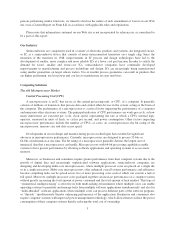AMD 2011 Annual Report Download - page 18
Download and view the complete annual report
Please find page 18 of the 2011 AMD annual report below. You can navigate through the pages in the report by either clicking on the pages listed below, or by using the keyword search tool below to find specific information within the annual report.because they may offer satisfactory graphics performance for most mainstream PC users, at a lower cost. Intel
could also take actions that place our discrete GPUs at a competitive disadvantage, including giving one or more
of our competitors in the graphics market, such as Nvidia Corporation, preferential access to its proprietary
graphics interface or other useful information.
As long as Intel remains in this dominant position, we may be materially adversely affected by Intel’s:
• business practices, including rebating and allocation strategies and pricing actions, designed to limit our
market share and margins;
• product mix and introduction schedules;
• product bundling, marketing and merchandising strategies;
• exclusivity payments to its current and potential customers and channel partners;
• control over industry standards, PC manufacturers and other PC industry participants, including
motherboard, memory, chipset and basic input/output system, or BIOS, suppliers and software
companies as well as the graphics interface for Intel platforms; and
• marketing and advertising expenditures in support of positioning the Intel brand over the brand of its
OEM customers.
Intel’s dominant position in the microprocessor market and integrated graphics chipset market, its existing
relationships with top-tier OEMs and its aggressive marketing and pricing strategies could result in lower unit
sales and a lower average selling price for our products, which could have a material adverse effect on us.
Other competitors include companies providing ARM-based designs used in the mobile and embedded
electronics market as relatively low cost and small microprocessors and also in form factors that offer an
alternative to mainstream PCs such as netbooks and tablets. ARM Limited designs and licenses its ARM
architecture and offers supporting software and services. Our ability to compete with companies who use
ARM-based solutions depends on our ability to design energy-efficient, high-performing products at an attractive
price point. In addition, Nvidia has begun to build custom CPU cores based on ARM architecture to support
future products ranging from PCs and servers to workstations and super computers.
Competition in the Chipset Market
In the chipset market, our competitors include suppliers of integrated graphics chipsets. PC manufacturers
use integrated chipsets because they cost less than traditional discrete GPUs while offering acceptable graphics
performance for most mainstream PC users. Intel manufactures and sells integrated graphics chipsets bundled
with their microprocessors and is a dominant competitor in this market.
Competition in the Graphics Market
In the graphics market, our competitors include suppliers of discrete graphics, embedded graphics
processors and integrated graphics chipsets. Intel manufactures and sells embedded graphics processors and
integrated graphics (IGP) chipsets, and is a dominant competitor with respect to this portion of our business.
The continued improvement of the quality of Intel’s integrated graphics, along with higher unit shipments of
our APUs, may drive computer manufacturers to reduce the number of systems they build paired with discrete
graphics components, particularly for mobile PCs, because they may offer satisfactory graphics performance for
most mainstream PC users, at a lower cost. Intel could take actions that place our discrete GPUs and integrated
chipsets at a competitive disadvantage such as giving one or more of our competitors in the graphics market,
such as Nvidia, preferential access to its proprietary graphics interface or other useful information.
12
























